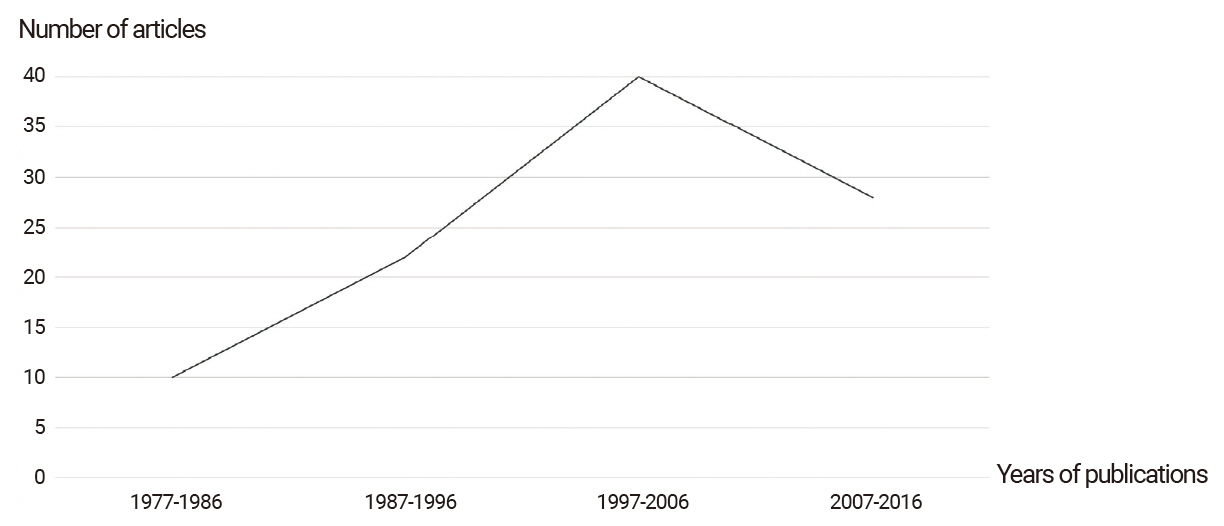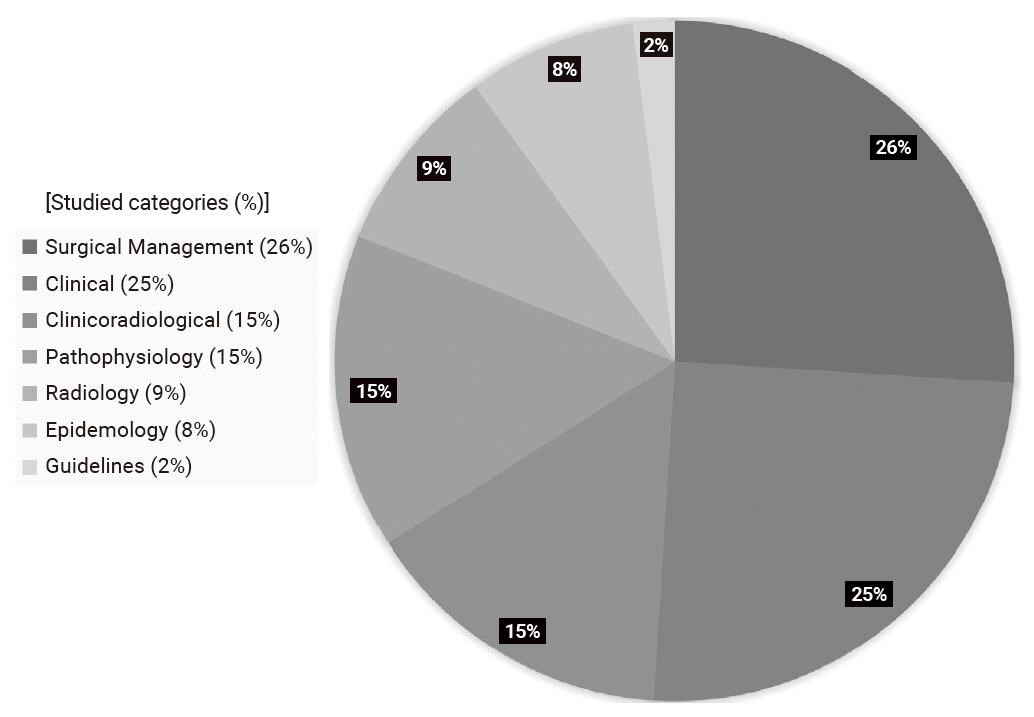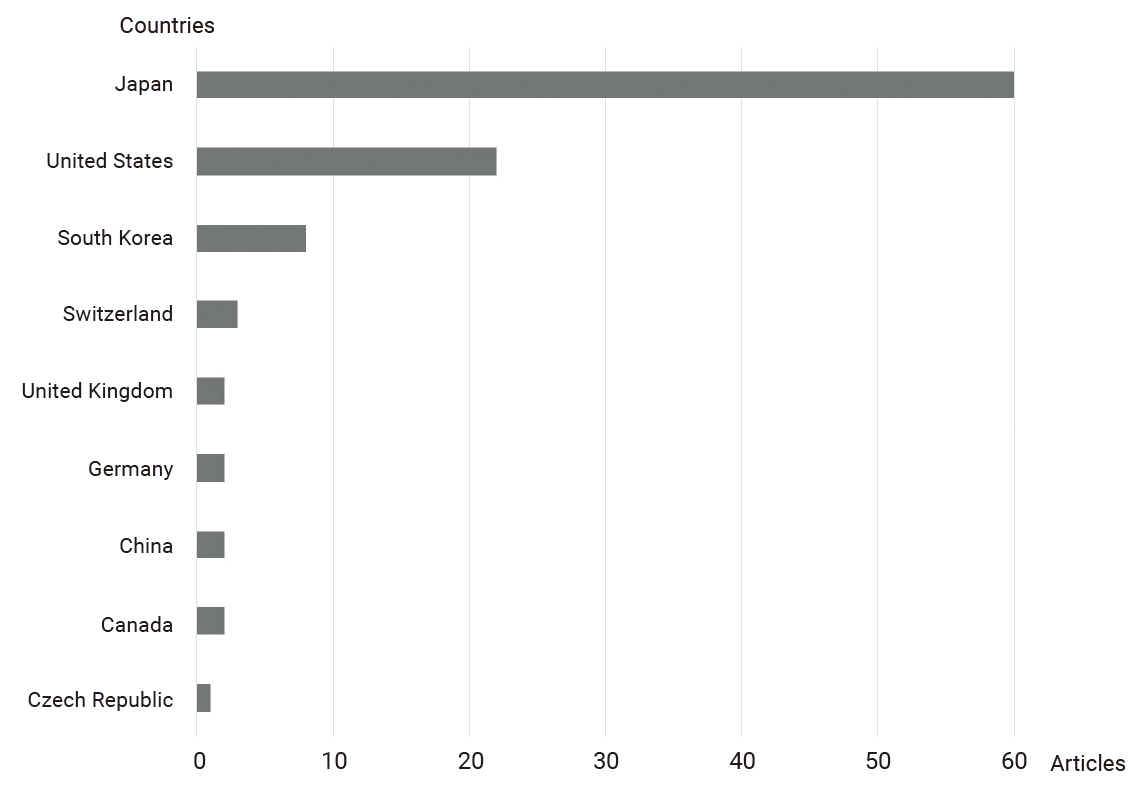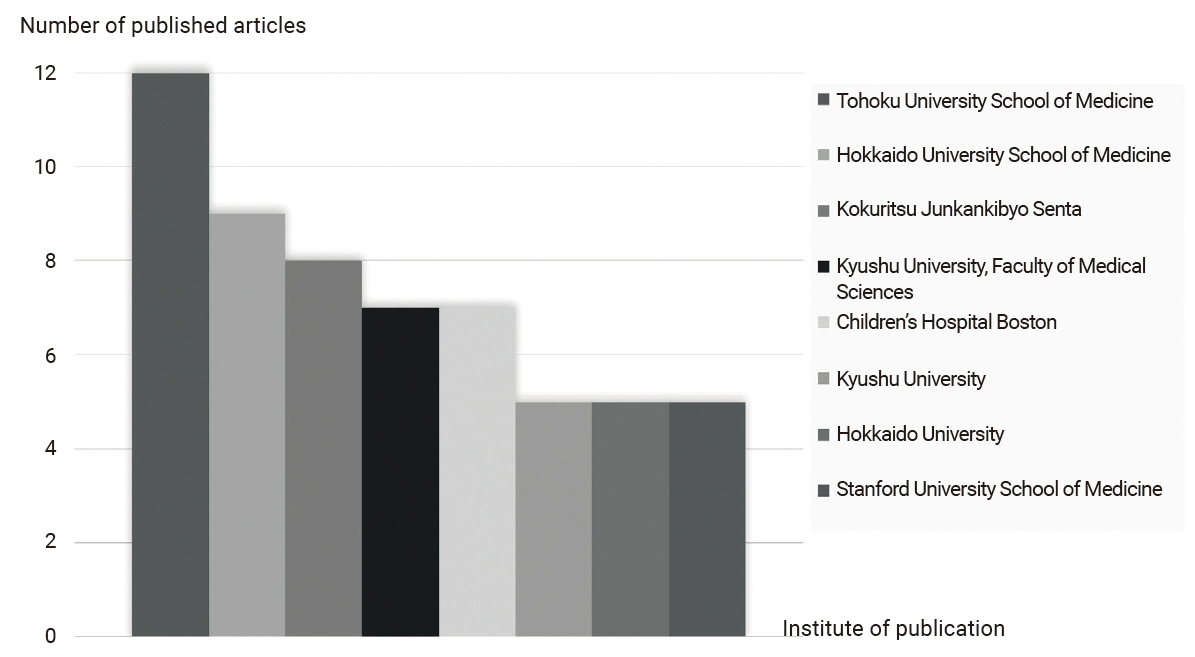J Cerebrovasc Endovasc Neurosurg.
2021 Jun;23(2):85-98. 10.7461/jcen.2021.E2020.09.004.
The Top-100 most cited articles on Moyamoya disease: A bibliometric analysis
- Affiliations
-
- 1Division of Neurosurgery, Department of Surgery, King Abdulaziz Medical City, Ministry of National Guard–Health Affairs, Riyadh, Saudi Arabia
- 2Department of Adult Neurosurgery, National Neurosciences Institute, King Fahad Medical City, Riyadh, Kingdom of Saudi Arabia
- 3Department of Neurological Surgery, University of Miami, Miami, FL, USA
- 4College of Medicine, King Saud bin Abdulaziz University for Health Sciences, Riyadh, Saudi Arabia
- 5MBBS, Alfaisal University, Riyadh, Saudi Arabia
- 6Neurocritical Care Division, Critical Care Administration, King Fahad Medical City, Riyadh, Kingdom of Saudi Arabia
- KMID: 2517021
- DOI: http://doi.org/10.7461/jcen.2021.E2020.09.004
Abstract
Objective
Moyamoya disease (MMD) is a progressive steno-occlusive cerebrovascular phenomenon with unknown pathogenesis. Considering the abundance of articles addressing Moyamoya disease, a detailed analysis concerning the publication trends is of paramount importance. The aim of the study is to report the current knowledge of the top-100 most cited articles on Moyamoya disease in the literature.
Methods
A non-time restricted keyword-based search was performed in June 2020 using the Scopus database. The search keywords included the following: “Moyamoya”, “Moyamoya disease”, and “Moyamoya syndrome”. The search result was used to rank the articles based on their citation count. The top-100 most-cited articles were obtained and classified into seven categories.
Results
A total of 3,543 articles on Moyamoya disease were published between 1955 and 2020. The Top-100 articles were published between 1977 and 2016 with a total of 16,119 citations, per year, and 7.23% rate of self-citation. The 1990s was the most productive decade (N=42). The most contributing country to the list was Japan (N=60). Stroke was the most active journal (N=23). Houkin, K., a Japanese neurosurgeon, was the most prolific author (N=15).
Conclusions
Moyamoya disease has been extensively investigated in the literature throughout the years. The majority of articles published in the literature were addressing the surgical management and clinical outcome. Authors from neurosurgical backgrounds were the most active contributors to the field of Moyamoya disease.
Keyword
Figure
Reference
-
1. Aksnes DW, Langfeldt L, Wouters P. Citations, citation indicators, and research quality: An overview of basic concepts and theories. SAGE Open. 2019; Jan-Mar. 9:1–17.
Article2. Alfaifi A, AlMutairi O, Allhaidan M, Alsaleh S, Ajlan A. The top 50 most-cited articles on acoustic neuroma. World Neurosurg. 2018; Mar. 111:e454–64.
Article3. Almutairi O, Albakr A, Al-Habib A, Ajlan A. The top-100 most-cited articles on meningioma, in world neurosurgery. World Neurosurg. 2017; Nov. 107:1025–32.4. Aoki N. Cerebrovascular bypass surgery for the treatment of Moyamoya disease: unsatisfactory outcome in the patients presenting with intracranial hemorrhage. Surg Neurol. 1993; Nov. 40(5):372–7.
Article5. Fujimura M, Kaneta T, Mugikura S, Shimizu H, Tominaga T. Temporary neurologic deterioration due to cerebral hyperperfusion after superficial temporal artery-middle cerebral artery anastomosis in patients with adult-onset moyamoya disease. Surg Neurol. 2007; Mar. 67(3):273–82.
Article6. Fukui M, Kono S, Sueishi K, Ikezaki K. Moyamoya disease. Neuropathology. 2000; Sep. 20 Suppl:S61–4.
Article7. Fung LWE, Thompson D, Ganesan V. Revascularisation surgery for paediatric moyamoya: A review of the literature. Child’s Nerv Syst. 2005; May. 21(5):358–64.
Article8. Goto Y, Yonekawa Y. Worldwide distribution of moyamoya disease. Neurol Med Chir (Tokyo). 1992; Nov. 32(12):883–6.
Article9. Guo DC, Papke CL, Tran-Fadulu V, Regalado ES, Avidan N, Johnson RJ, et al. Mutations in smooth muscle alpha-actin (ACTA2) cause coronary artery disease, stroke, and Moyamoya disease, along with thoracic aortic disease. Am J Hum Genet. 2009; May. 84(5):617–27.
Article10. Hallemeier CL, Rich KM, Grubb RL Jr, Chicoine MR, Moran CJ, Cross DT 3rd, et al. Clinical features and outcome in North American adults with moyamoya phenomenon. Stroke. 2006; Jun. 37(6):1490–6.
Article11. Hankinson TC, Bohman LE, Heyer G, Licursi M, Ghatan S, Feldstein NA, et al. Surgical treatment of moyamoya syndrome in patients with sickle cell anemia: outcome following encephaloduroarteriosynangiosis. J Neurosurg Pediatr. 2008; Mar. 1(3):211–6.
Article12. Hennessey K, Afshar K, MacNeily AE. The top 100 cited articles in urology. J Can Urol Assoc. 2009; Aug. 3(4):293–302.
Article13. Ikeda H, Sasaki T, Yoshimoto T, Fukui M, Arinami T. Mapping of a familial moyamoya disease gene to chromosome 3p24.2-p26. Am J Hum Genet. 1999; Feb. 64(2):533–7.
Article14. Ikezaki K, Matsushima T, Kuwabara Y, Suzuki SO, Nomura T, Fukui M. Cerebral circulation and oxygen metabolism in childhood moyamoya disease: A perioperative positron emission tomography study. J Neurosurg. 1994; Dec. 81(6):843–50.
Article15. Ikezaki K. Rational approach to treatment of moyamoya disease in childhood. J Child Neurol. 2000; May. 15(5):350–6.
Article16. Kamada F, Aoki Y, Narisawa A, Abe Y, Komatsuzaki S, Kikuchi AK, et al. A genome-wide association study identifies RNF213 as the first Moyamoya disease gene. J Hum Genet. 2011; Jan. 56(1):34–40.
Article17. Karasawa J, Kikuchi H, Kawamura J, Sakai T. Intracranial transplantation of the omentum for cerebrovascular moyamoya disease: A two-year follow-up study. Surg Neurol. 1980; Dec. 14(6):444–9.18. Karasawa J, Touho H, Ohnishi H, Miyamoto S, Kikuchi H. Cerebral revascularization using omental transplantation for childhood moyamoya disease. J Neurosurg. 1993; Aug. 79(2):192–6.
Article19. Kazumata K, Ito M, Tokairin K, Ito Y, Houkin K, Nakayama N, et al. The frequency of postoperative stroke in moyamoya disease following combined revascularization: a single-university series and systematic review. J Neurosurg. 2014; Aug. 121(2):432–40.
Article20. Kim JS. Moyamoya disease: Epidemiology, clinical features, and diagnosis. J Stroke. 2016; Jan. 18(1):2–11.
Article21. Kleinloog R, Regli L, Rinkel GJ, Klijn CJ. Regional differences in incidence and patient characteristics of moyamoya disease: a systematic review. J Neurol Neurosurg Psychiatry. 2012; May. 83(5):531–6.
Article22. Kobayashi E, Saeki N, Oishi H, Hirai S, Yamaura A. Longterm natural history of hemorrhagic moyamoya disease in 42 patients. J Neurosurg. 2000; Dec. 93(6):976–80.23. Kraemer M, Heienbrok W, Berlit P. Moyamoya disease in Europeans. Stroke. 2008; Dec. 39(12):3193–200.
Article24. Kudo T. Spontaneous occlusion of the circle of Willis. A disease apparently confined to Japanese. Neurology. 1968; May. 18(5):485–96.
Article25. Kuriyama S, Kusaka Y, Fujimura M, Wakai K, Tamakoshi A, Hashimoto S, et al. Prevalence and clinicoepidemiological features of moyamoya disease in Japan: findings from a nationwide epidemiological survey. Stroke. 2008; Jan. 39(1):42–7.26. Kuroda S, Hashimoto N, Yoshimoto T, Iwasaki Y; Research Committee on Moyamoya Disease in Japan. Radiological findings, clinical course, and outcome in asymptomatic moyamoya disease: results of multicenter survey in Japan. Stroke. 2007; May. 38(5):1430–5.27. Kuroda S, Ishikawa T, Houkin K, Nanba R, Hokari M, Iwasaki Y. Incidence and clinical features of disease progression in adult moyamoya disease. Stroke. 2005; Oct. 36(10):2148–53.
Article28. Lee S, Rivkin MJ, Kirton A, deVeber G, Elbers J; International Pediatric Stroke Study. Moyamoya disease in children: Results from the international Pediatric Stroke Study. J Child Neurol. 2017; Oct. 32(11):924–9.
Article29. Liu W, Morito D, Takashima S, Mineharu Y, Kobayashi H, Hitomi T, et al. Identification of RNF213 as a susceptibility gene for moyamoya disease and its possible role in vascular development. PLoS One. 2011; 6(7):e22542.
Article30. Matsushima T, Inoue K, Kawashima M, Inoue T. History of the development of surgical treatments for moyamoya disease. Neurol Med Chir (Tokyo). 2012; 52(5):278–86.
Article31. Miyamoto S, Yoshimoto T, Hashimoto N, Okada Y, Tsuji I, Tominaga T, et al. Effects of extracranial-intracranial bypass for patients with hemorrhagic moyamoya disease: Results of the Japan adult moyamoya trial. Stroke. 2014; May. 45(5):1415–21.32. Nah HW, Kwon SU, Kang DW, Ahn JS, Kwun BD, Kim JS. Moyamoya disease-related versus primary intracerebral: Hemorrhage location and outcomes are different. Stroke. 2012; Jul. 43(7):1947–50.33. Nasir SAR, Gilani JA, Fatima K, Faheem U, Kazmi O, Siddiqi J, et al. Top 100 most-cited articles on spontaneous intracerebral hemorrhage: A bibliometric analysis. World Neurosurg. 2018; Feb. 110:445–9.
Article34. Pagni M, Khan NR, Cohen HL, Choudhri AF. Highly cited works in radiology: the top 100 cited articles in radiologic journals. Acad Radiol. 2014; Aug. 21(8):1056–66.35. Poor G, Gacs G. The so called ‘Moyamoya disease’. J Neurol Neurosurg Psychiatry. 1974; Apr. 37(4):370–7.36. Scott RM, Smith ER. Moyamoya disease and moyamoya syndrome. N Engl J Med. 2009; Mar. 19. 360(12):1226–37.
Article37. Scott RM, Smith JL, Robertson RL, Madsen JR, Soriano SG, Rockoff MA. Long-term outcome in children with moyamoya syndrome after cranial revascularization by pial synangiosis. J Neurosurg. 2004; Feb. 100(2 Suppl Pediatrics):142–9.
Article38. Shuaib W, Acevedo JN, Khan MS, Santiago LJ, Gaeta TJ. The top 100 cited articles published in emergency medicine journals. Am J Emerg Med. 2015; Aug. 33(8):1066–71.
Article39. Suzuki J, Kodama N. Moyamoya disease-a review. Stroke. 1983; Jan-Feb. 14(1):104–9.
Article40. Suzuki J, Takaku A. Cerebrovascular “Moyamoya” disease. Disease showing abnormal net-like vessels in base of brain. Arch Neurol. 1969; Mar. 20(3):288–99.41. Takeuchi K, Shimizu K. Hypogenesis of bilateral internal carotid arteries. No to Shinkei. 1957; 9:37–43.42. Yamada I, Suzuki S, Matsushima Y. Moyamoya disease: comparison of assessment with MR angiography and MR imaging versus conventional angiography. Radiology. 1995; Jul. 196(1):211–8.
Article43. Zhang H, Zheng L, Feng L. Epidemiology, diagnosis and treatment of Moyamoya disease. Exp Ther Med. 2019; Mar. 17:1977–84.
- Full Text Links
- Actions
-
Cited
- CITED
-
- Close
- Share
- Similar articles
-
- Contemporary research trends on nanoparticles in endodontics: a bibliometric and scientometric analysis of the top 100 most-cited articles
- Understanding anterior communicating artery aneurysms: A bibliometric analysis of top 100 most cited articles
- The most influential articles on kidney transplantation: a bibliometric and visualized analysis
- A bibliometric analysis on the most-cited publications on carotid endarterectomy throughout history
- The Top-100 most cited articles on dural arteriovenous fistula: A bibliometric analysis







